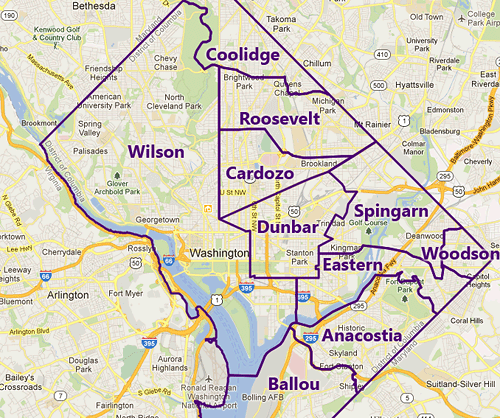School boundary review, part 1: Committee grapples with a changed DC, while parents worry
The committee that has been reviewing DC’s school boundaries and feeder patterns will unveil several possible scenarios for a new assignment system on April 5. In the meantime, anxiety abounds in some neighborhoods.
DC’s school assignment system hasn’t been revised since 1968. A lot has changed since then, and DC officials say it’s necessary to adjust school attendance zones to accommodate those changes. But some parents and prospective parents say existing boundaries and feeder patterns should stay in place until schools across the District have improved.
The Deputy Mayor for Education (DME), Abigail Smith, is in charge of the boundary overhaul process. A 23-member advisory committee, composed of parents and community members representing every ward in the District, has been meeting since October. The DME’s office has also convened focus groups to get feedback and has held community meetings.
The next phase of the process will begin April 5, when several proposed school assignment scenarios will be presented, and working groups will begin to meet to discuss them. The presentations will be open to the public, and community members can sign up to participate in the working groups.
Three different community meetings will be held in three different sectors of the District: Center City (at Dunbar HS), East End (at Anacostia HS), and Upper NW & NE (at Coolidge HS). While residents are free to attend any of the meetings, and the presentations will be the same, the working groups will focus on schools in the area where the meeting is located.
The committee plans to release its recommendations in July, and the mayor will announce a final plan in September. Changes won’t go into effect until the 2015-16 school year.
The case for change
In a presentation to the Chevy Chase ANC on March 10 that was similar to those she has given elsewhere, Smith made a case for revising the assignment process without further delay. Current attendance zones are based on housing and school attendance patterns of the 1970s, she said, resulting in imbalances and inequities.
The lines were drawn when many in Ward 3 weren’t sending their kids to neighborhood schools, and as a result the Wilson High School boundary includes 40% of the District’s land mass. Smith said that Wilson now has about 500 8th-graders destined to become its entering freshman class. But Roosevelt High School only has around 50, even though 2000 high-school-age kids live within the Roosevelt boundaries.
The current zones and feeder patterns also don’t take account of the existence of charter schools and the closures of many DCPS schools. Since 1996, 58 such schools have closed. In other cases, such as the Duke Ellington School of the Arts in Georgetown, schools have changed from being neighborhood schools to magnet schools.
The result, Smith said, is that some schools are overcrowded while others are half empty. To make matters more complex, 23% of all DCPS students attend schools that aren’t the schools they’re assigned to, and only 25% do attend their in-boundary school.
Whether or not students attend their in-boundary school also varies greatly from ward to ward. In Ward 3, nearly all students attend their in-boundary school. But in Wards 7 and 8, nearly 80% either go to out-of-bounds DCPS schools or to charters.
The committee is also considering feeder patterns that would cross between DCPS and charter schools, with certain charter schools possibly giving a preference to students coming out of certain DCPS schools or vice versa. But, says Claudia Lujan, a senior policy adviser to the DME, the DC Council would need to change the law before charters could be required to admit particular students.
Different assignment models
The advisory committee has been looking at school assignment policies in 7 different cities. The models vary in the degree of choice allowed. At one end of the spectrum, a district may rigidly assign each family to a certain sequence of schools. At the other, as in San Francisco, there are no attendance zones, and families can express preferences but have no right to attend any particular school.
“The assumption,” Smith said, “is that we won’t end up at either extreme.”
But it’s still unclear exactly where we will end up. Smith and others on the committee have said repeatedly that “everything is on the table.” While that phrase conveys open-mindedness, it’s also so open-ended that it’s caused anxiety among parents who don’t know what to expect.
Tomorrow, in the next part of this post, we’ll look at parents and prospective parents at two elementary schools in Northwest DC who are urging officials to retain the boundaries and feeder patterns we have now, at least until all schools in the District have reached a higher level of quality.

